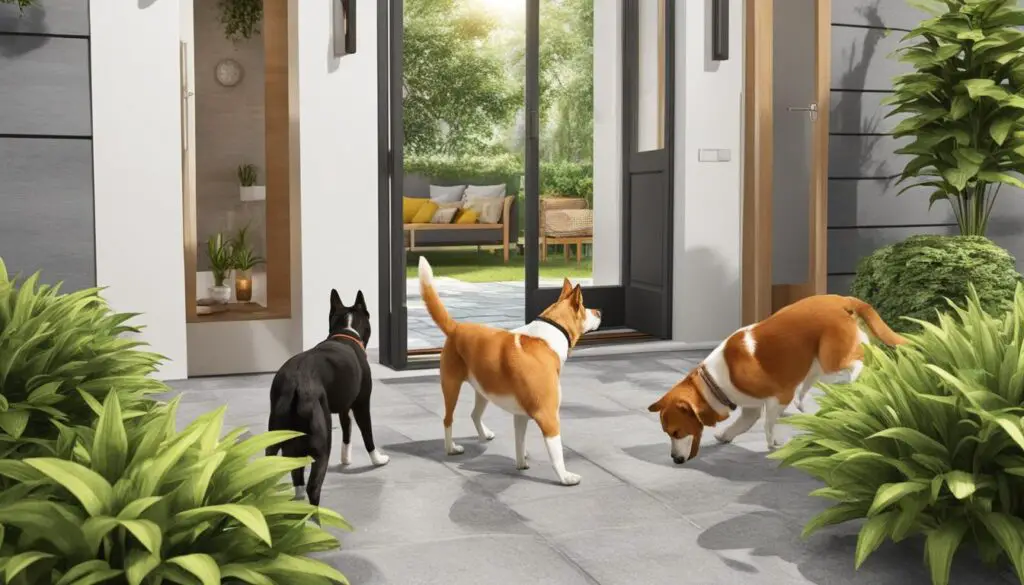Introducing a new pet to a resident small pet can be a delicate process that requires careful planning and execution. By following effective strategies, you can establish a harmonious household where all your furry friends can coexist peacefully. In this article, I will explore expert advice and tips to help you navigate the introduction process with confidence.
Find a Good Match
When introducing a new pet to your resident small pet, it’s important to find a good match. Inquire with shelters or rescue organizations about cats that have experience with dogs or adopt a dog-savvy cat. Look for a cat that is confident but calm, as a fearful or high-energy cat may trigger a dog’s natural instinct to chase. Similarly, if you’re adopting a dog and have a resident cat, choose a dog with a history of living with cats or a puppy that can be properly socialized from a young age.
| Cat | Dog | |
|---|---|---|
| Traits | Confident but calm | History of living with cats or socializing a puppy |
| Compatibility | ||
| Benefits | – Reduces the risk of conflicts – Establishes a peaceful environment | – Facilitates a smoother introduction – Increases the chances of successful coexistence |
Provide Separate Safe Areas for Your Dog and Cat
When bringing a new cat home, it’s essential to provide a separate safe area where the dog isn’t allowed. This allows the cat to have a space of their own and minimizes potential conflicts between the two pets.
Supervised interaction can take place outside these separate areas, ensuring that both pets are introduced gradually and under controlled circumstances. This step helps establish boundaries and reduces the risk of any negative encounters.
By providing separate safe areas, you give your new cat the opportunity to adjust to their new surroundings without feeling threatened by the presence of the dog. This safe space gives them a sense of security and allows them to become familiar with their new environment at their own pace.
During the initial introduction phase, it’s crucial to supervise interactions between the dog and cat. This supervision ensures that any interactions are controlled and can be intervened if needed, preventing any potential conflicts or harm to either pet.
“Creating separate safe areas for your dog and cat is a key step in introducing them to each other. It allows them to establish their own territories and helps prevent any negative encounters that could lead to fear or aggression.”
Supervised interaction outside the safe areas allows the pets to gradually become acquainted with each other’s scents and presence. It’s important to start with short, supervised sessions and gradually increase the duration as both pets become more comfortable.
Remember, patience is essential during this process. Each pet will have their own unique adjustment period, and it’s crucial to respect their individual needs and boundaries. By providing separate safe areas and supervised interactions, you can create an environment where your dog and cat can eventually coexist harmoniously.
Next, we’ll explore the importance of keeping introductions slow and positive for a successful integration.
Keep Your Introductions Slow and Positive
When introducing a new pet to your household, it’s crucial to approach the process with patience and positivity. Slow introductions allow your pets to become familiar with each other gradually, reducing the chances of conflicts and anxiety. By implementing a few key strategies, such as utilizing gates and leashes and rewarding calm behavior, you can foster a harmonious environment for your furry friends.
Gates and leashes: Using gates and leashes during the initial introductions can help you maintain control and manage the interactions between your pets. This allows them to get accustomed to each other’s presence while ensuring that neither feels overwhelmed. By utilizing physical barriers, you can provide a sense of safety and security for both pets.
Rewarding calm behavior: Positive reinforcement is a powerful tool when it comes to introducing new pets. Whenever your pets interact calmly and peacefully, be sure to reward them with treats and praise. This reinforces their good behavior and encourages positive associations with each other. It’s essential to focus on rewarding peaceful interactions rather than paying attention to any negative behaviors that may arise.
“Rewarding calm behavior creates a positive association between your pets, encouraging them to engage in more harmonious interactions.”
However, it’s important to monitor the level of excitement or focus displayed by either pet. If one becomes too fixated or overly excited, it’s best to create some distance or try again later. This helps prevent any potential conflicts and ensures a controlled and positive introduction process.
Remember, each pet is unique, and the introduction process may vary depending on their personalities and past experiences. By taking it slow, providing controlled interactions, and rewarding calm behavior, you can increase the chances of a successful integration and foster a harmonious household for all your pets.
Conclusion
Introducing new pets to a resident small pet can be a challenging process, but with the right strategies and approach, you can create a harmonious household for all your furry companions. By following expert advice and tips, you can ensure a successful integration and foster strong bonds between your pets.
One of the key strategies for success is finding a compatible match. Whether you’re introducing a new cat or a dog, consider their previous experience with other pets and their temperament. Look for a cat with experience with dogs or a dog with a history of living with cats. This increases the chances of a positive interaction and reduces the risk of conflicts.
Additionally, providing separate safe areas for your pets is crucial. This gives each pet their own space where they can feel secure and retreat when needed. It’s important to supervise their interactions outside these safe areas, allowing them to gradually get acquainted with each other under controlled circumstances.
Keeping introductions slow and positive is another key strategy. Use gates and leashes to maintain distance between the pets when necessary, allowing them to familiarize themselves without feeling overwhelmed. Reward calm behavior from both the dog and cat to reinforce positive interactions. If either pet becomes too focused or excited, create some distance and try again later to prevent any potential conflicts.
Remember, patience is key throughout the process. Introducing new pets takes time and effort, but by following these strategies, seeking professional help if needed, and remaining patient, you can create a harmonious household where all your pets can live together happily.
FAQ
How can I find a good match when introducing a new pet to my resident small pet?
Inquire with shelters or rescue organizations about cats that have experience with dogs or adopt a dog-savvy cat. Look for a cat that is confident but calm and choose a dog with a history of living with cats or a puppy that can be properly socialized from a young age.
Why is it important to provide separate safe areas for my dog and cat?
Providing separate safe areas allows the cat to have a space of their own and minimizes potential conflicts between the two pets. Supervised interaction can take place outside these separate areas, ensuring that both pets are introduced gradually and under controlled circumstances.
What should I do to keep introductions slow and positive?
Use gates and leashes to maintain distance between the pets when needed, allowing them to familiarize themselves without feeling overwhelmed. Reward calm behavior from both the dog and cat, providing treats and praise whenever they interact peacefully.
How can I create a harmonious household when introducing new pets?
By finding a compatible match, providing separate safe areas, keeping introductions slow and positive, and rewarding calm behavior, you can set the stage for a successful integration. Remember to be patient and seek professional help if needed.






No Comments